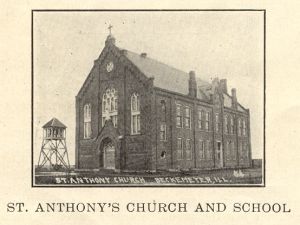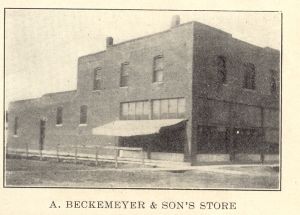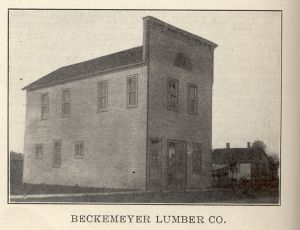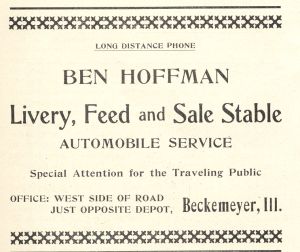|
Page 14 |
|
|
The Village of Beckemeyer was organized in 1905 by Aug. BECKEMEYER and several other prominent citizens of that place. Previously it had been known as Buxton, and is sometimes called by that name still. It has a population of approximately seven hundred souls. The town has one mill, one mine, one zinc smelter, two banks, one saw and grist mill, three large general stores and two smaller ones, two hotels, one restaurant, seven saloons, one barber shop, a telephone exchange, one large hardware store, two lumber yards, two livery stables and a host of smaller concerns. During the year 1911 an oil boom was started in Beckemeyer, which for a time seemed destined to become the greatest oil center in the state. Many thousands of prospectors hurried to the little city and began buying up options and leases, but when the true amount of oil was discovered the boom gradually diminished. Early in 1912 there were twenty-five producers north of the city. The field is two miles long and one mile wide. Shortly after the oil was examined the Ohio Oil Company bought up all the leases of the independent owners and paid $1,500,000 for the field. They have a large force of employes at work the year around. The oil is pumped to the main pipe line running north of the city and thence into Wood River, Ill. St. Anthonyís Parish The village of Beckemeyer and surrounding settlement was first called Buxton. An excellent coal vein, underlying the whole settlement, gave rise to the sinking of a coal-mining shaft in 1894. This brought new life into that part of the country, growth to the village and necessitated the establishment of a Catholic congregation. The first Catholic settles were Nicolaus ISAAK in 1837, his son Frank, who is still living, 83 years of age, John Baptist FREANT and John Baptist PEPPENHORST, 1838. These were immigrants from Alsace-Lorraine. Immigrants from the northern part of Germany, viz.: Hanover, Oldenburg and Westphalia were Henry GERVERSMANN, 1840; Joseph OSTERMANN, 1847; then during the years 1850 till 1860 Gerhard FOECKE, Herman HEITMANN, Henry FIDELER, Joseph ROBERG, |
John G. TAPHORN, Peter ROHR, Frank NORDMANN, Henry REILMANN, Bernard and Fritz ECKELMANN, Henry HILMES, Frank LANDWEHR, and Patrick MURPHY from Ireland. The first and present pastor, Joseph J. HOELLMANN, received his appointment October 2nd, 1905; the church was
dedicated and opened for divine service December 19th, 1905. Before this time the parishioners now constituting St. Anthonyís Church, attended church first at Germantown, later at Carlyle, Breese and Bartelso respectively. The first and present church, a brick structure on rock foundation, was erected by J. J. HOELLMANN in 1905. It is a two-story building, the first story being used for school purposes and the second story for divine services. The outside dimensions of the building are 43X85 feet, the seating capacity of the church is 224 seats. The whole building is furnished with a steam heating system; the total cost of the structure including the necessary furniture was $17,753.34. The first and present rectory a 1 Ĺ story frame structure, 39X40 feet, was built on Lots No. 4 and 5 in Block No. 9 of SUHL and HUELSMANNís Addition to Beckemeyer by J. J. HOELLMANN at a total cost of $2,500. In 1906 Lot No. 3 in Block No. 9 was added to the property and in 1907 |
|
Page 15 |
|
|
this property was sold to St. Anthonyís Congregation for a remuneration of $2,000. The school was opened January 2nd, 1906. It is a graded school, divided into three rooms and conducted by the Sisters of the Poor Handmaids of Jesus Christ, Fort Wayne, Ind. The average number of children attending is 125. The Sisterís residence, a two-story frame structure on concrete foundation with basement, was built in 1912 at a total cost of $2,558.54. The St. Anthonyís Hall, a frame structure of 32X80 feet, was built by St. Anthonyís Improvement an Entertainment Club in 1909 at a cost of $1,200. The combination church and school, the Sisterís residence and St. Anthonyís hall are situated in Block NO. 2 TAPHORNís Addition, donated by John G. TAPHORN. Block No 4 in SUHL and HUELSMANN Addition to Beckemeyer,
donated by A. SUHL and F. HUELSMANN, is reserved for a larger and more pretentious church building. There are 6 societies in the parish: St. Josephís Men Society with 38, St. Annís Ladiesí Society with 50, St. Aloysius Young Menís Sodality with 27, St. Agnes Young Ladiesí Sodality with 39, St. Anthonyís I. & E. Club with 70 and Branch No. 107, W. C. U., with 22 members. The parish consists of about 125 families, mostly native Americans of German descent, some of Irish descent; about 16 families being Lithuanian immigrants. Exceptional benefactors in establishing the congregation were John G. TAPHORN, Bernard HOLTHAUS, Sr., Henry HOLTHAUS, Sr., Anton SUHL and Frederic HUELSMANN. In 1906 two acres of ground and a road 16 Ĺ feet wide and 10 acres long leading to the same were bought of Henry HOLTHAUS, Sr., at a price of $250. This is being used for cemetery purposes. Rev. Joseph J. HOELLMANN, the present pastor of St. Anthonyís Church at Beckemeyer, Ill., was born at Warendorf in Westphalia, Germany, June 30th, 1869; studied 6 years at the Gymnasium at Warendorf, Wesphalia, came to the U.S. of America in February 18909; studied philosophy at St. Francis Solanus College, Quincy, Ill., in 1891 and 1892; studied theology at Mount St. Maryís Seminary, St. Meinrad, Ind.; was ordained to the Priesthood by Rt. Rev. John JANSSEN in St. Peterís Cathedral, Belleville, Ill., on December 26th, 1894; was assistant at St. Dominicís Church, Breese, Ill., from June 30th, 1895 till October 2nd, 1905, from thence was sent to Beckemeyer, Ill., to establish and take charge of the new St. Anthonyís Congregation. Bank of Beckemeyer The Bank of Beckemeyer was organized in 1906. The following substantial citizens are stockholders of this enterprising banking institution: Thos. E. FORD, A. F. GROSS, F. H. ALBERS, Philip SCHAFER, Theo. ZIEREN, John J. ONEILL, John B. WULLER, George BERGER and F. C. MAHLANDT. Mr. MAHLANDT is cashier and Mr. FORD, of Carlyle, is president. The bank is a private banking institution, and is a branch |
of the Farmerís and Merchantsí Bank of Carlyle. The bank is equipped with an up-to-date safe and vault of the John Baumann type and is burglar and fire proof. The bank owns its own building which was erected at a cost of $3,000.00. It is a one-story fire proof brick structure and is one of the finest buildings in the city. The bank does a general banking business and its deposits have been on the increase for the past seven years. Mr. MAHLANDT has been cashier since June, 1907; he was a school teacher for nine years previous to starting in the banking business. He taught in the Beckemeyer school two years and the country school near Beckemeyer for seven years. He was married in 1903 to Sophia KRONE. He was born in the county north of Beckemeyer in 1878 and was educated in the county grade schools, and the High school at Carlyle. In connection with the banking business he is also doing an insurance business, representing four different companies of fire, lightning and tornado insurance. He is also a Notary Public and has been Village Clerk for the past seven years. As a side line he deals in real estate. H. B. BREFELD In 1907
Mr. BREFELD
started into the
hardware business in Beckemeyer. Feeling that the town needed a real
live
hardware store, he took it upon himself to start a store there, and,
leaving his
fatherís lace of business in Aviston, he located in Beckemeyer. He
started in
with a stock of goods valued at $7,000.00. His yearly business will run
way up
into the thousands. He sells hardware, stoves, tinware, guttering,
roofing,
cutlery, sporting goods, sewing machines, bicycles, paints, oils,
repairs for
all stoves, sewing machines, pumps and does plumbing. He is also
engaged in the
business of installing heating and lighting plants, hot air furnaces,
and does
tinning of all kinds. For many years previous to opening in Beckemeyer
he was
connected with his father G. BREFELD. He was born
in Aviston in 1870. He
was married in 1905 to Anne E. EILERMANN and has
one child, a boy named
Marshall. Mr. BREFELD was elected President of the
Village Board, or
Mayor, in 1922, and has filled the office successfully. During his
administration he passed many bills for the interest of Beckemeyer and
in
consequence he is held in high esteem among the residents of the city
and
surrounding country. He has one of the best stocked stores of his kind
in the
county. BECKEMEYER and Son The above named firm is the oldest and largest general store in the city. It is located south of the tracks and is housed in a fine two-story brick building. The store was started in the early days of the city, when it was known as Buxton and was located in a small frame building. Two years ago the firm moved into its new building, which is the largest in the city. Mr. August BECKEMEYER, the Senior |
|
Page 16 |
|
|
member of the firm is one of the pioneers in the county, having settled there when the county was in its infancy. The store occupies a floor space of 40X86 feet, including a warehouse adjoining the main building on the south. The second floor is used as a rooming house, and is the only one of its kind in the city, and one of the best furnished apartments in the county. Oscar W. BECKEMEYER, the active manager of the store, has been a member of the firm for five years. He was born in 1882 and attended the common schools of the county, and the High school at Carlyle. Later he attended the University of Illinois and graduated from that institution in 1907. He took a business course in the College of Literature and Arts and is one of the most brilliant young men in the City of Beckemeyer. The store is a part of the town in several ways, but chiefly because of the fact that it is the oldest and largest and conducted by honest business men such as the BECKEMEYERís are. Mr. Aug. BECKEMEYER is also head of the BECKEMEYER bank, a private banking institution adjoining the Post Office. ZINSCHLAG Brothers There is a story connected with the saloon conducted by the above named brothers. It was started in 1900 by A. E. and Wm. ZINSCHLAG. In 1902 A. E. sold out his interests to William and located in Frogtown and operated a saloon and grocery there for 19 months. After the 19 months had passed he returned to Beckemeyer and formed a partnership with Hy. STROATHIDE, and was connected with him three months when he bought him out. He operated the saloon for two years by himself, finally selling and embarking in the saw mill business with Frank GINTER. In 1905 he went back into the saloon business again with Richard PFEIFFER as a partner. After he sold out to him he bought out the interests of C. BAYLESS, who was conducting a wet goods emporium in the building he is now located in. He remained there eight months and closed up the place and left for Carlyle, where he opened a saloon and stayed six months. Then he came back to Beckemeyer and took in his brother, E. A., and they have conducted the stand ever since. They are wholesalers and retailers of wines, whiskey and cigars and have a large trade. They handle all the leading brands of wines, liquors and cigars and make a specialty of selling Lemps and Central beer. The saloon is the largest in the city and has in connection a pool hall. A. E. has been a resident of Beckemeyer off and on for over thirteen years while E. A. has only been living there for six years. A. E. was born in the county in 1864 and received his schooling |
in its common schools. He was married in 1891 to Elizabeth BECKEMEYER; from this union three children sprang. After the death of his first wife he again married in 1902. His second wifeís name was Jessie SHEPHARD; three children graced this marriage. All six of the children are living. E. A. was born in the county in 1876 and was also educated in the county schools. A. E. has been township commissioner and school trustee at different times and for a time handled insurance as a side line. Beckemeyer Lumber Yard The oldest lumber yard in the city is the one operated and conducted by the above named company. It was started in March, 1904, by H. C. and Fred BECKEMEYER. H. C. BECKEMEYER died in 1911 and Fred and his brother Emil took possession. In March 1912, Fred became sole owner of the yard. As manager of the yard he has increased the sale yearly until today the yard does more business than any other in the city. A full and complete line of lumber, lath, shingles, mill work, building material, lime, cement, plaster and everything that goes to make up a first class yard is sold in stock. The yard has a capacity of twenty carloads of lumber and it is filled to its capacity the year around. The business done by the firm is enormous; lumber is shipped all over the southern and eastern part of the county. Fred BECKEMEYER was born in Beckemeyer in 1876 and is the son of H. C. and Elizabeth BECKEMEYER, pioneers of the city. He is one of 11 children. H. C. BECKEMEYER was a native of Minden, Germany, and married Elizabeth SCHROEDER, of Breese, in 1866. He fought during the civil war with Company C, Second Missouri Heavy Artillery, for he was living in Missouri at the outbreak of the war. He settled in Clinton county in 1865, after being discharged from the army and started into business shortly after. For a time he was
farming and owned a large farm near the City. Fred has been City Treasurer and served from 1906 to 1908 in that capacity. From 1906 to 1909 he was Township Clerk which office he held for two years while serving a City Treasurer. He is an industrious young man and has a host of friends. Ben HOFFMANN The above named started into business in the City of Beckemeyer in December, 1912. The livery and sales stable, of which he is now owner and manager, has been in Beckemeyer for the past eight years and in point of service, is the oldest one in the city. In addition to doing a general livery business, Mr. HOFFMANN also has an automobile for the accommodation of passengers and traveling men. He makes a specialty of carrying them all over the county. He sells corn, oats, feed, etc. He was born in Litchfield, Ill., February 19th, 1885, and moved with his |
|
Page 17 |
|
|
parents to St.Louis when quite young. He attended the public schools there and later moved to Cuba, Mo., where he finished his education. For a time he lived in Litchfield, and worked as a carpenter and bartender. The livery business he now conducts on the street facing the railroad in Beckemeyer is a paying business and Mr. HOFFMANN has the friendship and good will of every citizen of the city. EULOGY OF THE FARMER. The farmer's fight is fought alone. He has not the comfort and support of masses of his fellows. In the solitude of his broad acres he faces the active hostility of Nature, or her exasperating forgetfulness of him and his interests. He must maintain his courage and his diligence, when great lazy summer clouds drift above his fields whose contents would be beyond price to him, and yet spill not a drop on his thirsty lands. More: he must hold a reserve of faith and hope stronger than the effect even of a succession of bad seasons. He must rise, as soon as the tale of the loss of an unproductive year is told, to plant again. This is less on the economic side, but it is gain in other realms. In the past the best manhood of the nation has been drawn from its farms. In hand-to-hand conflict with Nature, sometimes winnnig and something losing, but always unconquered within, the farmer has developed an independence, a pelf-reliance, an inward strength which have given his sons leadership in the city, in the school, and in the councils of the State. As the debt of America to the rural home is cast up who shall say how much of it is owing to the days of trial and of loss? When the farmer's grain fields have yielded scarcely seed for another year's planting he has demonstrated by his courage and his hope that man must not live by bread alone. When the autumn found him emptyhanded he has lived in the faith of the coming spring. When he has not added to the riches of the nation in material things he has laid up other and more precious possessions, possessions whose command makes the corner stone of the State more secure and holds with secure hand the promise of the future. In the value of all crops
the West North Central division ranks first,
its crops in 1909 being valued at $1,445,909,000, or 26.4 per cent. of
the total for the country. Of the value of all crops the North reported
56.9 per cent, the South 35 per cent, and the West 8.1 per cent. The
proportion east of the Mississippi was 54.1 per cent and that west of
the Mississippi 45.9 per cent. |
COLLEGE OF LITERATURE AND ARTS. Of the one hundred thirty-eight students who graduated from the College of Literature and Arts at the University of Illinois, forty-eight (13 men and 35 women) have enrolled with the Appointments Committee looking forward to securing positions as teachers in the secondary schools and as principals and superintendents. Of this number eighteen have reported that they have already received appointments. Twenty-one of the forty-eight desiring positions as teachers have had experience as teachers The salaries of those who have reported range between $600 and $1,800. The demand for well trained teachers is very great, and there is little doubt but that all of the graduates who desire to teach will secure desirable appointments. LAW GRADUATES PLAN TO PRACTICE THEIR PROFESSION IN ILLINOIS. Of the twenty-five law students taking degrees, twenty-two received the degree of bachelor of law and three the degree of doctor of law. Four of the number are already licensed to practice, and the remainder plan to take the bar examinations in July. Most of them expect to open offices for practice in Illinois. One of the notable successes in this year's class is Mr. W. D. Farthing, who in spite of blindness, has completed a three-years' course in the law school. Mr. Farthing is a graduate of McKendree College, and with the aid of his brother who reads for him, he has made an excellent record as a student. The brothers will open an office and practice law together in Southern Illinois. FURTHER ELECTRIFICATION OF PENNSYLVANIA RAILROAD. It is stated that the branch of the Pennsylvania Railroad between Philadelphia, Pa., and Washington, D. C., will be electrified within two years. Power will be obtained from a new plant to be erected at Conowingo, on the Susquehanna River. Sites for transforming and switching stations have already been acquired between Baltimore and Washington, it is reported. WIRELESS TELEPHONY. A test was recently made at Rome of the apparatus of Professors Moretti and Vanni for telephoning without wires. Calls were made from Rome to the wireless station at Penzano, Maddalena, Palermo and Trapani with entire success. Palermo is in the island of Sicily, about 250 miles from Rome. This invention has been presented to the Italian government and will be used by the army and probably made a monopoly. It is expected to operate with a station in Tripoli without difficulty. In Germany the women are still gleaners in the fields. Some use hand rakes, six feet long, with long wooden teeth, which they draw slowly through the stubble, combing out the scattered grain. I have seen old women with a big basket on a hand cart, plodding all day through the stubble picking up single heads of wheat and getting a basket full in the day's work. This is the modern "Ruth gleaning in the fields of Boaz." Women do not work in all these occupations from choice but from necessity. The earnings of the husband are not sufficient to support the wife and family and each must work in some earning capacity. One cause for the demand for female labor on the farms is the vast number of men in the armies in these old countries, although in Germany, at times, the soldiers are sent to their homes to assist in gathering the harvests. Illinois, judged by the total value of all crops, was in 1909 the leading agricultural state, followed by Iowa, Texas, Ohio, Georgia, Missouri, New York and Indiana, each reporting more than $200,000,000 worth of crops raised annually. |






